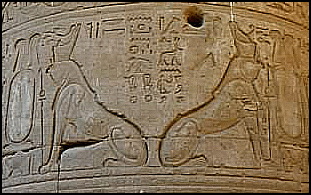لمشاهدة الفيديو اضغط هنا

The Great Sphinx, carved from bedrock at
Giza, is a unique monument. There had been nothing like it before, and nothing like it was to be constructed on the same scale since. But in ancient Egyptian iconography, sphinxes usually traveled in pairs. Could there have been a second Great Sphinx at Giza? Archaeologist Michael Poe is certain of it. He wrote:
There is currently absolutely no archaeological evidence of Khephren 'repairing' the Sphinx. There are two ancient Egyptian references, both during the Middle Kingdom, at a considerably later time. One has it that Khephren found the Sphinx (which would support the Sphinx is older than Khepern), and that Khephern altered it's face. This same source (fragmentary papyrus) said that there was another Sphinx facing this one on the other side of the Nile, and both were built here to represent the dividing line between Northern and Southern Egypt. The other reference said that Khephren built the Sphinx.
Have you ever seen just one Sphinx in later Egypt that didn't have another? Not only did the ancient Egyptians mention a second Sphinx, but so did the Greeks, Romans, and Muslims. It was destroyed between 1000-1200 ad.
At the entrance to buildings and temples there are two Sphinxes, side by side, but on the avenue or approach to the temple they are facing each other. Sometimes they may have as much as 100 or so facing each other in the avenue. The Nile is Egypt's avenue between North and South. All of the writings about the two Sphinxes say that they were facing each other. The second one, by the way, was partly destroyed during a high Nile flood, and then completely destroyed by ensuing Moslems carting it off to rebuild their villages.
Poe has more recently added the following information:
I'm not particularly proposing it's absolutely true, after all the people in Egypt in the 1000-1200's were subject to telling some pretty big stories (so are some the present day "guides").
It was, as I recall, made out of mudbrick and faced with stone. It makes sense that the stone would disappear around 1200 ad, Cairo had a large earthquake and the people used facing stones from the Great Pyramid to rebuild part of the town and would also use the ones at the 2nd Sphinx. That would leave the mudbrick to deteriorate to the weather, and the Nile gradually moved east away from the pyramids and may have engulfed and erased the 2nd Sphinx.
The Arab writers who mention a 2nd Sphinx are:
Al-I'Drisi (AD 1099-1166) who wrote about it in Kitab al-Mamalik wa al-Mansalik (a large geographic encyclopedia) and Al-Kitab al-Jujari, a geographical encyclopedia on Asia and Africa. He describes a second sphinx across the Nile from the first in very bad state of repair, made of mud (bricks?) and faced with stone, most of the stone having been hauled away by local inhabitants and now the Nile "lapping at it's feet." He doesn't say if it was the same size, but since the Nile moved further east after AD 1166, then it would have been destroyed.
Ibn Battuta (AD 1307-1377) in his Travels in Asia and Africa doesn't mention it, either because it doesn't exist, or has already been destroyed by then (it was written around AD 1325-1354).
Musabbihi mentions a smaller Sphinx across the Nile from the large one "south of Cairo" in a "ruined state of brick and stone" in the Annals of Rabi II around AD 1024.
Nasir-i Khosrau visited Egypt between Aug 1047 and April 1048 and heard rumors of a second one but apparently never looked for it or saw it.
It could have been a larger than usual Sphinx that normally lines the road to a temple and was the last of the line left after the Nile crept over to the location and destroyed all the others, easy to visualize as the destruction of the outer stones of the others would leave the mudbrick exterior subject to the flooding of the Nile.
Horus sphinxes at Edfu.
© Photo copyright Larry Orcutt
Authors Graham Hancock and Robert Bauval also believe that a second sphinx was likely. In their book The Message of the Sphinx, they maintain that the Sphinx was made to represent Atum-Harmachis (Harmachis being the Greek rendering of Hor-em-Akhet or Horus-in-the-Horizon). A stele of Amenhotep II names the Great Sphinx as both Hor-em-Akhet and Horakhti. The authors note that both names are frequently translated as "Horus-of-the-Two-Horizons." They write:
So if Hor-em-Akhet is the Great Sphinx in the western 'Horizon of Giza,' then should we not look for Horakhti, his, 'twin,' in the eastern horizon of the sky? [p. 162]
Assuming Michael Poe is correct with his details, there would be no trace remaining of the alleged second Sphinx, for on the eastern bank of the Nile there is nothing but city. Any evidence of such a monument would have been erased forever. There is little to support the notion that such a second sphinx ever existed at all, however. Despite Hancock and Bauval's assertions, the Great Sphinx was not identified with Hor-em-Akhet until centuries after the close of the Old Kingdom. In Riddles of the Sphinx, Paul Jordan wrote:
It [the Great Sphinx] might possibly have had a companion if its sculptors had cared to repeat the exercise of carving it... The later sphinxes of Egypt were often installed as pairs to guard entrances to significant places... An eminent Egyptologist once spent some time looking for another Great Sphinx on the other side of the river, but eventually gave up the idea. [p. 1]
Although Jordan does not name this individual, it is very likely W.M. Flinders Petrie, the "father of modern Egyptology." Margaret Drower, author of a recent biography of Petrie, wrote (Flinders Petrie: A Life in Archaeology, p. 353):
As the season neared its end [1921-22], news came of the death of Mrs Urlin; Hilda hurried home, but Flinders stayed on a little in Cairo; he wanted to test a theory that the Great Sphinx at Giza might have had a counterpart on the other side of the Nile; he walked from Ma'adi over every foot of the ground opposite the pyramids, examining each outcrop of rock, and decided that there was no evidence for a contra-sphinx.
Commentaire personnel du traducteur: A noter que, si l'article est toujours en ligne, aucune preuve n'est venue depuis étayer les dires de Bassâm Al Chammâ', soient presque 6 années de silence. Pourquoi en parler, me direz-vous ? Pour savoir et éviter que cette annonce soit présentée ailleurs sous un jour faussement meilleur.« Modifié: 02 Avril 2014 à 23:33:12 par katchina » IP archivéetitilapin2***Hors ligne Hors ligneSexe: HommeMessages: 2308en l'honneur de ma fille"THE SECOND SPHINX THEORY"
By its original author
BASSAM SHAMMAH Lectrer and auther in Egyptolog. Graduated of Victory Collage in Alexandria Studied Ancient Egyption Pharaonic ,Greco- Roman, Islamic and Modern History at the Faculty of Tourism,Helwan University Cairo Has lectured throughout USA ,Egypt ,Europe South Africa .Radio and T.V. history editor.
This theory was born at the same time that the word symmetrical was born. The ancient Egyptian artist always depicted his scenes, drew his characters on papyri ,painted the walls of the tombs and temples and erected his obelisks and statues in a harmonical and symmetrical manner. It became an artistic and religious tradition that lasted throughout the Pharaonic epoch. The facade of the temple was a ways built in the form of two pylons (fortress-like construction), symbolizing the two eternal hills forming a design, which was definitely copied from nature. With the sun setting between these two rising hills, it provided the ancients the description of the horizon. Two mounds, with the solar disc in between was the "AKER" or horizon.
Symetry was also in the end position of the royal statues , like those, which are in front of the Ramses 11 pylons of Luxor Temple. There were three in front of each pylon. Two seated and flanking the entrance and four standing statues, two on each side of the pylon. There were also two identical obelisks erected in front of the seate figures, the eastern one is still there, the western one is now in the Concorde Square in Paris,France.
***
There were double avenues of sphinxes to guard and protect the Pharaoh during his passing in and out of the temple. Protection always came from both sides the passerby, his left and right side. Of course, it is not logical to protect someone from one side only, as that would easily allow evil, whatever it is or wherever it is coming from, or in whatever form it comes according to the belief of the period, to attack from the unprotected side. Therefore, by adding symmetry to logic, it is only correct to believe that there should not be one lion or sphinx on its own in ancient Egypt. Moreover, there are more reasons to make us believe in this concept, this time it is documented.
According to the Heliopolitan cult, the creator of the whole universe was"Atum"(spelled Tem in some hieroglyphic texts). This was the first appearance of th sun deity of Heliopolis, who later took on many forms and various names, like "Ra" referring to the sun in its midday phase, when it is strong and most powerful. The priest also called the sun deity "Khepri," referring to the sun in its early day phase, during and after sunrise. But, Atum was the sun during sunset. Depending upon pre-dynastic beliefs, cults and traditions the priests of ancient Egypt wrote,composed and carved on the pyramids burial chambers walls hymns and magical texts. They were called "The Pyramid Texts." The most important collection of such texts are on the walls of the burial chambers of the pyramids of Pharaoh Unas or Wenis (23562323 BQ and Pharaoh Teti (2323-2291 BQ in Saqqarah. These magical utterances contain prayers and explanations of how and why the deities came into existence, also, the religious relationship between the creations and nature in the most poetic, romantic, and sometimes exotic ways. The most pioneering pyramid concerning the pyramid texts is the Wenis Pyramid, it was called, "the pyramid which is beautiful of places," it was originally 43 meters high, its angle was 56" 18' 35", its base is 57.5 meter square.Teti followed in Wenis footsteps; he called his pyramid "the pyramid, which is enduring of places."












